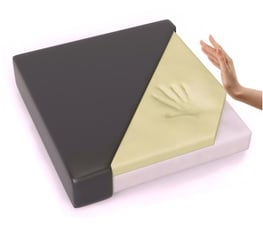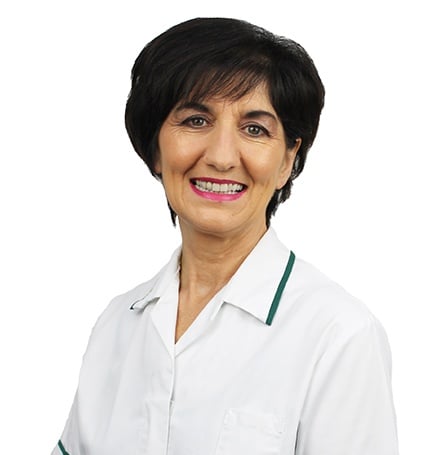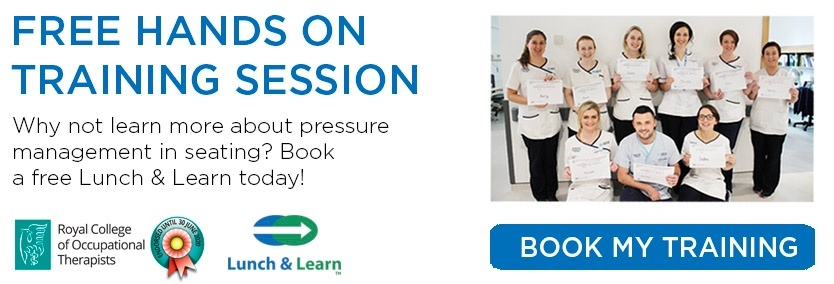A pressure injury is a localised injury to the skin and/or underlying tissue, usually over a bony prominence caused by pressure or pressure in combination with shear. Pressure injuries are a preventable injury and can cause serious health issues to elderly, sick or immobile individuals.
BOOK A FREE LUNCH & LEARN TRAINING SESSION
Martina Tierney, Occupational Therapist and Clinical Director of Seating Matters has dedicated most of her 30 year career to researching the impact of specialised seating on the quality of life of patients across the world.
The experienced clinical team at Seating Matters take pressure management very seriously and much consideration is given to the quality of pressure management in our chairs.
The Seating Matters cushion is made from two distinct layers: memory foam and Dartex. This combination offers the patient a medium to high pressure redistribution. Currently too much emphasis is placed on the cushion (surface) alone as a means of pressure management. However, in order to achieve maximum pressure management in a chair, The Four Principals of Pressure Mangement in Seating are recommended.
The Seating Matters Cushion
- Layer 1: 2 inches of memory foam to allow immersion and envelopment of the Ischial Tuberosities (ITs) into the cushion, this immersion gives stability and reduces shear and friction.
- Layer 2: A dense foam which provides stability to the memory foam to prevent bottoming out.
The cushion is then covered by a Dartex material, which will fit the contours of both the cushion and body giving the required level of support. Dartex fabrics also offer great stretch recovery which will help prevent sagging and will therefore provide a more comfortable and effective support surface for longer. With the Dartex cover, the cushion offers a degree of moisture vapour permeability to ensure that the cushion remains dry and comfortable. Any surface next to the skin can interfere with its natural temperature and moisture control can also aggravate the risk to the patient. This is avoided by using Dartex. The cushion will give sufficient anti-slip, as excess surface friction can add to the risk of developing a pressure injury.

All Seating Matters chairs come as standard with a removable cushion. This facilitates the use of any other cushion which may be prescribed by the clinician.
Often clients only think of the cushion in the chair when considering pressure management. New industry leading research by Ulster University* and Seating Matters has revealed there are four areas that collectively, should be adhered to to ensure that optimum pressure management is achieved whist seated, not just the cushion. Results were staggering when these steps were implemented correctly, including a reduction in pressure injuries.
BOOK A FREE LUNCH & LEARN TRAINING SESSION
The Four Principals of Pressure Management
- Loading the Body
When you increase an individual’s surface area contact with their chair, you reduce the pressure exerted through any one point. This is achieved through correct seat dimensions – seat height, depth, width, foot plate height and angle.
- Provide Postural Support
Proper support for the patient will help maintain a mid line posture and manage the distribution of pressure throughout the body. This is achieved through correct seat dimensions plus head, lateral and leg supports.
- Effective Re-Positioning
Guidelines recommend that seated individuals are re-positioned every 2 hours. This increases the blood flow and the amount of oxygen reaching the skin. Research shows that 45° tilt can maximise the potential for significant blood flow increase and pressure reduction, this is achieved using tilt in space in the Phoenix™ and Sorrento™ chairs and back angle recline.
- Use an Appropriate Surface
The Seating Matters cushion is a visco memory foam based cushion coated in Dartex, an anti-shear, multi stretch material. This allows any bony prominences to emerge into the foam, helping achieve maximum surface area contact and helping to reduce interface pressure. The fact that the material is breathable helps reduce the risk of pressure ulcers developing by reducing moisture on the surface of the skin.
BOOK A FREE LUNCH & LEARN TRAINING SESSION
References
*Daly, O., Casey, J., Martin, S., Tierney, M. & McVey, O. (2013) The effectiveness of specialist seating provision for nursing home residents, Ulster University.
* These results should not be interpreted as a predictor or guarantee of future financial or clinical outcomes with different patients. Clinicians and users must employ correct decision making, undertake proper assessments, education, comply with local regulations and ensure correct use of equipment. The resulting report from this randomized control trial shows that the study consisted of 38 participants from 3 nursing home settings, who were randomly assigned to control and intervention groups using computer-generated numbers. The study’s results in regard to pressure ulcers has been calculated from the change in pressure ulcers/pressure injuries/skin redness in both the intervention and control group. As a pilot study of a specific nature, it was not blinded. The measurement of pressure ulcers was observational and the analysis of the results included various forms, not including statistical analysis. The study has been reviewed and presented at over 30 academic conferences in 3 continents and is pending publication in a respected peer-reviewed journal.






